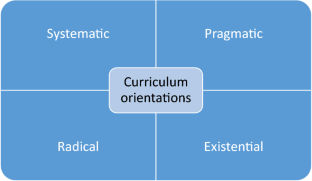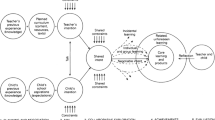Abstract
Few matters are of greater importance to high quality early childhood education than the content and mediation of curriculum. In spite of this, early childhood curriculum practices are rarely examined through the lens of curriculum theory. This research employs educational connoisseurship and criticism as a methodology to shed light upon the curriculum discourse and practices at one public elementary school in relation to one preschool classroom. The findings indicate multiple curriculum orientations subtly coexist at the school. We argue that identifying stakeholders' curriculum orientations and understanding how they operate in the context of a particular school provides a basis for more generative curriculum deliberations that make use of the strengths and recognize the limitations of disparate curricular traditions.

Similar content being viewed by others
References
Brown, C. P., & Barry, D. P. (2020). Public policy and early childhood curriculum in the United States. In J. J. Mueller & N. File (Eds.), Curriculum in early childhood education: Re-examined, reclaimed, renewed (2nd ed., pp. 17–33). New York: Routledge.
Castner, D. J. (2020). Early childhood curriculum leadership: Towards a critical and pragmatic framework. In D. D. Cunningham (Ed.), Professional and Ethical Considerations for Early Childhood Leaders. IGI Global.
Creswell, J. W. (2007). Qualitative inquiry & research design: Choosing among five approaches (2nd ed.). Sage.
Eisner, E. W., & Vallance, E. (1974). Conflicting conceptions of curriculum. McCutchan.
Eisner, E. W. (2002). The educational imagination: On the design and evaluation of school programs. Prentice Hall.
Eisner, E. W. (1991). The enlightened eye: Qualitative inquiry and the enhancement of educational practice. Macmillan.
File, N. (2020). Curriculum and research: What are the gaps we ought to mind, redux. In J. J. Mueller & N. File (Eds.), Curriculum in early childhood education: Re-examined, reclaimed, renewed (2nd ed., pp. 17–33). New York: Routledge.
Goffin, S. G. (2001). Wither early childhood care and education in the next century. In L. Corno (Ed.), Education across a century: The centennial volume. University of Chicago Press.
Graue, M. E., Ryan, S., Nocera, A., Northey, K., & Wilinski, B. (2017). Pulling preK into a K-12 orbit: The evolution of preK in the age of standards. Early Years, 37(1), 108–122. https://doi.org/10.1080/09575146.2016.1220925
Hesse-Biber, S. N., & Leavy, P. (2006). The practice of qualitative research. Sage.
Hlebowitsch, P. S. (2005). Designing the school curriculum. Pearson Inc.
Joseph, P. B. (2011). Cultures of curriculum (2nd ed.). Routledge.
McMillan, J. H., & Schumacher, S. (2010). Research in education: Evidence-based inquiry (7th ed.). Pearson.
Morgan, H. (2007). Early childhood education: History, theory, and practice. Rowman & Littlefield.
National Association for the Education of Young Children (NAEYC). (2020, April). Developmentally Appropriate Practice (DAP) Position Statement. https://www.naeyc.org/resources/position-statements/dap/contents.
Null, W. (2016). Curriculum: From theory to practice (2nd ed.). Rowman & Littlefield Publishers.
Rubin, H. J., & Rubin, I. S. (2005). Qualitative interviewing: The art of hearing data (2nd ed.). Sage.
Schwab, J. J. (1973). The practical 3: Translation into curriculum. School Review, 79, 501–502.
Stake, R. E. (2008). Case studies. In N. K. Dennzin & Y. S. Lincoln (Eds.), Handbook of qualitative research (2nd ed., pp. 435–454). Sage.
Style, E. (1997). Curriculum as window and mirror. Holistic Education Review, 10(3), 49–53.
Urmacher, P. B., Moroye, C. M., & Flinders, D. J. (2017). Using educational criticism and connoisseurship for qualitative research. Routledge.
Walker, D. F. (2003). Fundamentals of curriculum: Passion and professionalism (2nd ed.). Lawrence Erlbaum Associates.
Wood, E., & Hedges, H. (2016). Curriculum in early childhood education: Critical questions about content, coherence, and control. Curriculum Journal, 27(3), 387–405.
Author information
Authors and Affiliations
Corresponding author
Additional information
Publisher's Note
Springer Nature remains neutral with regard to jurisdictional claims in published maps and institutional affiliations.
Rights and permissions
About this article
Cite this article
Castner, D.J., Fajerstein, L. & Butera, G. The Good that’s Within You: A Case Study of Early Childhood Curriculum Practice. Early Childhood Educ J 50, 1047–1058 (2022). https://doi.org/10.1007/s10643-021-01243-9
Accepted:
Published:
Issue Date:
DOI: https://doi.org/10.1007/s10643-021-01243-9




